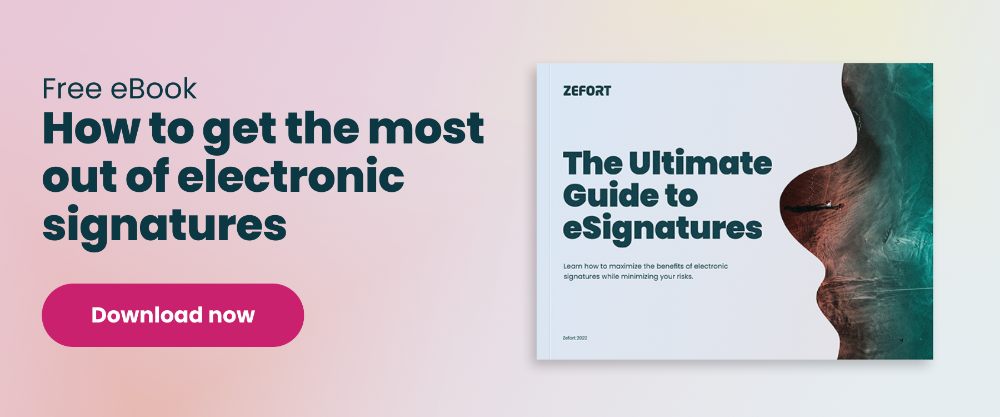Yes, electronic signatures are legally binding – here’s why
Are electronic signatures legal? Do they hold up in a court of law? The answer to these very common questions is easy: yes, just like their ink-and-paper counterparts, eSignatures are a safe, legal way to sign contracts.
In this post, we’ll take a quick look at what exactly makes eSignatures legal. We’ll also touch on what makes electronic signatures even more secure than traditional signatures.
eIDAS makes eSignatures legal in the EU
The European Union and its eIDAS regulation make the situation very clear for EU countries: digital signatures are as legally binding as traditional ink on paper.
Since its launch in 2014, the eIDAS regulation has made several types of electronic signatures legally binding and enforceable. In addition to clearing the legal status of digital signatures, eIDAS provides a framework and standards for electronic identification (eID), electronic signatures and digital documents in its member countries. So, by using an eID service, you can verify the signer’s identity when making the signature.
However, it’s helpful to know that not all EU member states necessarily offer a national solution for digitally verifying the signee’s identity. This does not mean that you can’t use electronic signatures in these countries: you can still utilize a basic-level signature through email, for example.
If you have the option, always prefer electronic signature methods with strong identity verification. Strong authentication results in a digital fingerprint, a logged signing event stored in a digital seal in the original signed PDF document. Therefore, it’s much easier to verify these signatures later if needed.
3 levels of electronic signatures
The European Union eIDAS digital identification regulation defines three levels of electronic signatures: basic, advanced, and qualified electronic signatures.
At the basic level, a name written in an email constitutes a binding electronic signature, for example. The advanced electronic signature (AES) adds a level of security, as the signature is uniquely linked to the signee through an electronic identification (eID) service. The qualified signature level defined by eIDAS requires that the signee uses a dedicated qualified signature creation device (QSCD) when signing the document.
eSignatures outside the EU
Outside the EU, the legal validity of eSignatures varies country by country. For example, throughout the United States, electronic signatures have the same legal status as handwritten signatures, due to the E-Sign Act (2000) and the Uniform Electronic Transactions Act (UETA). Remember to check the legal status of eSignatures before you enter a new market.
eSignatures come with built-in security
Compared to their traditional counterparts – a stack of paper signed with a pen on its last page – digital signatures have a lot to offer in terms of safety and security.
First, using digital signatures implies that you are utilizing digital documents as part of your process. That’s great – a digital process is likely to be faster and more efficient. In addition, it’s much easier to archive and backup a digital document, keeping it safe for future use.
When a document is sealed with a digital signature, it becomes nearly impossible to forge or counterfeit. If you open a document with an altered signature in Adobe Reader, for example, the reader instantly informs you that the signature has been tampered with. Also, a digital signature adds a timestamp for the signature – the document always indicates exactly the exact date and time of signing.
Further, with digital signatures, you do not have to send duplicates of your documents via email. You can simply share a signing link to the document stored in your signing service. This way, you get to control who has access to the document while not having to worry about different document versions.
Metadata ensures authenticity
When a document is signed in accordance with eIDAS, it includes metadata on the signing certificate, the signing service that was used and other technical details, such as information on the digital seal used to protect the document. It is important to save the original version of the signed digital document: edited digital versions or printed copies lose all the metadata.
Want to learn more about eSignatures?
No matter if you are a seasoned expert on digital signing or just getting started, we recommend checking out Zefort’s free eBook The Ultimate Guide to eSignatures. It’s a good resource to get started on the basics but also touches on topics like optimizing your CLM process and discovering how you can boost your business with digital signing.





